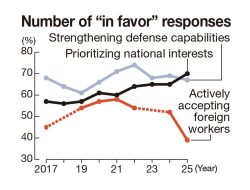
December 3, 2021
One of the most notable promotion strategies in the fashion industry over the past two decades must be making use of influencers on social media. In fact, it is becoming increasingly common for fashion brands to promote their products through YouTubers and Instagrammers who have millions of followers.
Another promotion tactic is collaboration, which started out with the basic pattern of an established designer’s brand tying up with an inexpensive fast fashion brand. For fast fashion brands, such collaborations provide the public with topics of discussion, while the strategy appeals to designer brands because it publicizes their names and brings in a good amount of collaboration fees.
For example, the collaboration between H&M and Comme des Garcons in 2008 shortly after the former brand’s arrival in Japan that year reportedly endowed the latter a collaboration fee of several hundred millions of yens. In return, H&M won a stamp of approval for being seen as a brand that cares about designers’ creativity by teaming up with Comme des Garcons, the champion of avant-garde fashion with many enthusiastic followers.
Fast fashion had a bad reputation for copying existing products and exploiting cheap labor in developing countries. The collaboration thus gave fast fashion brands an excellent opportunity to raise their status. It was obvious which benefited more from the project.
When you hear the word “collaboration,” you may think of those joining up in the fields of fashion, apparel and sports. It is notable that now a new member has joined the party: the restaurant industry. The budget restaurant industry, to be precise. Such collaborations likely make headlines and publicize the collaborators’ names even though questions remain when a brand’s image is taken into consideration.

There have been some different and surprising collaborations recently. First is the Rageblue brand of Adastria Co. collaborating twice on advertisements with the gyoza dumpling restaurant franchise Gyoza no Ohsho — first in August last year and then in April this year. A gyoza restaurant brings to mind the smell of garlic, grease and smoke — not at all fashionable. Yet the collaboration was repeated because it proved popular. I think we have to change the way we look at collaborations.
Fashion products went on sale on Nov. 5 that are a collaboration between Punyus, a clothing brand produced by popular comedian Naomi Watanabe, and Saizeriya, a budget Italian restaurant chain. Apparently, Watanabe is a big Saizeriya fan and persuaded the restaurant chain to collaborate with her brand for one year. To me, the collaboration doesn’t seem to help raise the status of either. If I am forced to think of any merit, it’s probably that both will gain more publicity.

Japanese fashion brands are not the only ones jumping on the collaboration bandwagon. Surprisingly, French sports brand Le coq sportif, which is distributed by Descente Ltd. in Japan, has collaborated with popular ramen restaurant chain Tenkaippin. They agreed on the collaboration as this year happens to be an anniversary year for both — the 50th anniversary of Tenkaippin and the 30th anniversary of Le coq sportif’s iconic LCS R sneaker series. On Nov. 10, the 50th anniversary of the ramen chain, the sneakers’ collaboration model LCS R800 Z1 TI went on sale for ¥14,300. The new model is based on LCS R800 Z1 and adorned with the Tenkaippin logo on the side panels. The beige color comes from the thick ramen soup the ramen chain is known for, while the signature rooster emblem of the sports brand on the heel tab has been changed to a skeleton, recalling the chicken carcass stock used in ramen. The colors used come from noodles — negi green onions and pork. The insoles not only bear an illustration of a dragon, but also the words “We’ll be waiting for you again tomorrow,” which are written on the bottom of a Tenkaippin’s ramen bowl and are visible only when the customer has fully consumed the soup. I’m amazed Le coq sportif headquarters in France accepted the whole idea.
Surprisingly, however, somehow collaborations rarely flop. Even if they do, all the collaborators have to do is stop the project immediately, and consumers will only remember that they had made headlines, with little damage done to the brands. This is the merit of collaborations. What the three examples I have given share in common is that they all have subtle humor. Perhaps many people have unwittingly smiled at the collaborations as life without anything to smile at continues amid the pandemic.
"Editorial & Columns" POPULAR ARTICLE
-

Corporate Interim Earnings: Companies Must Devise Ways to Overcome Trump Tariffs
-

Violations of Subcontract Law: Major Automakers Must Eliminate Old Practices
-

Local Governments’ Tax Revenues: Devise Ways to Correct Imbalances in Tax Sources
-

Takaichi’s Summit with Economics-Minded Trump Successfully Advanced Japan’s Security Interests
-

Lower House Budget Committee: Unrestrained Fiscal Stimulus Is Unacceptable
JN ACCESS RANKING
-

Govt Plans to Urge Municipalities to Help Residents Cope with Rising Prices
-

Japan Resumes Scallop Exports to China
-

Japan Prime Minister Takaichi Vows to Have Country Exit Deflation, Closely Monitor Economic Indicators
-

Japan to Charge Foreigners More for Residence Permits, Looking to Align with Western Countries
-

JR East Suica’s Penguin to Retire at End of FY2026; Baton to be Passed to New Character






















